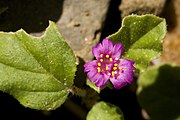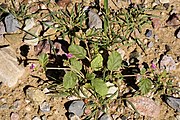| Allionia incarnata | |
|---|---|
 | |
| In Nevada | |
| Scientific classification | |
| Kingdom: | Plantae |
| Clade: | Tracheophytes |
| Clade: | Angiosperms |
| Clade: | Eudicots |
| Order: | Caryophyllales |
| Family: | Nyctaginaceae |
| Genus: | Allionia |
| Species: | A. incarnata |
| Binomial name | |
| Allionia incarnata | |
| Varieties [1] | |
| |
| Synonyms [1] [2] [3] | |
List
| |
Allionia incarnata is a flowering plant in the four o'clock family (Nyctaginaceae) native to the Caribbean, the southern United States, and south through Central America and most of western South America. [1] It is a perennial (sometimes annual) herbaceous plant with dark pink flowers. [4] Allionia incarnata is known as pink three-flower, pink windmills, trailing allionia, trailing four-o'clock, and trailing windmills. [4]
Three varieties are accepted: [1]
- Allionia incarnata var. incarnataL.
- Allionia incarnata var. nudata(Standl.) Munz
- Allionia incarnata var. villosa(Standl.) B.L.Turner


